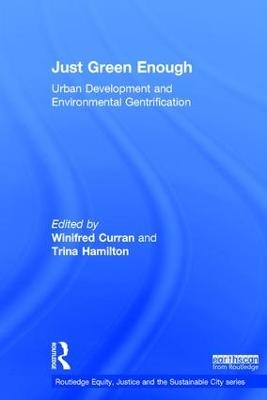
Just Green Enough
Routledge (Verlag)
978-1-138-71379-6 (ISBN)
While global urban development increasingly takes on the mantle of sustainability and "green urbanism," both the ecological and equity impacts of these developments are often overlooked. One result is what has been called environmental gentrification, a process in which environmental improvements lead to increased property values and the displacement of long-term residents. The specter of environmental gentrification is now at the forefront of urban debates about how to accomplish environmental improvements without massive displacement.
In this context, the editors of this volume identified a strategy called "just green enough" based on field work in Greenpoint, Brooklyn, that uncouples environmental cleanup from high-end residential and commercial development. A "just green enough" strategy focuses explicitly on social justice and environmental goals as defined by local communities, those people who have been most negatively affected by environmental disamenities, with the goal of keeping them in place to enjoy any environmental improvements. It is not about short-changing communities, but about challenging the veneer of green that accompanies many projects with questionable ecological and social justice impacts, and looking for alternative, sometimes surprising, forms of greening such as creating green spaces and ecological regeneration within protected industrial zones.
Just Green Enough is a theoretically rigorous, practical, global, and accessible volume exploring, through varied case studies, the complexities of environmental improvement in an era of gentrification as global urban policy. It is ideal for use as a textbook at both undergraduate and graduate levels in urban planning, urban studies, urban geography, and sustainability programs.
Winifred Curran is an Associate Professor of Geography at DePaul University, USA. Trina Hamilton is an Associate Professor of Geography at the State University of New York at Buffalo (UB), USA.
Contents
Contributors
Acknowledgements
Illustrations
Foreword
Introduction
Just Green Enough in Transition
Just Green Enough: Contesting Environmental Gentrification in Greenpoint, Brooklyn
Winifred Curran and Trina Hamilton
A just enough green? Industrial gentrification and competing socionatures in Greenpoint, Brooklyn
Winifred Curran and Trina Hamilton
Making Just Green Enough advocacy resilient: Diverse economies, ecosystem engineers and livelihood strategies for low-carbon futures
Sarah Dooling
Just Transition and Just-Green-Enough: Climate justice, economic development and community resilience
Julie Sze and Elizabeth Yeampierre
Green Displacements and Community Identity
Greening the waterfront? Submerging history, finding risk
Pamela Stern and Peter V Hall
Alternative food and gentrification: Farmers’ markets, community gardens and the transformation of urban neighborhoods
Pascale Joassart-Marcelli and Fernando Bosco
The production of green: Gentrification and social change
Jessica Ty Miller
State-led Environmental Gentrification
Environmental gentrification in Metropolitan Seoul: The case of greenbelt deregulation and development at Misa Riverside City
Jay E. Bowen
Displacement as disaster relief: Environmental gentrification and state informality in developing Chennai
Priti Narayan
Fixing sustainability: Social contestation and re-regulation in Vancouver’s housing system
Noah Quastel
Mobilizing and Planning for Just, Green Futures
Mobilizing community identity to imagine just green enough futures: A Chicago case study
Leslie Kern
Bring on the Yuppies and the Guppies! Green gentrification, environmental justice, and the politics of place in Frogtown, L.A.
Esther Kim
The contested future of Philadelphia’s Reading Viaduct: Blight, neighborhood amenity, or global attraction?
Hamil Pearsall
Informal urban green space as anti-gentrification strategy?
Christoph D. D. Rupprecht and Jason A. Byrne
Patient Capital and Reframing Value: Making New Urbanism Just Green Enough
Dan Trudeau
Index
| Erscheinungsdatum | 13.06.2018 |
|---|---|
| Reihe/Serie | Routledge Equity, Justice and the Sustainable City series |
| Zusatzinfo | 3 Tables, black and white; 24 Halftones, black and white; 24 Illustrations, black and white |
| Verlagsort | London |
| Sprache | englisch |
| Maße | 156 x 234 mm |
| Gewicht | 498 g |
| Themenwelt | Naturwissenschaften ► Biologie ► Ökologie / Naturschutz |
| Naturwissenschaften ► Geowissenschaften ► Geografie / Kartografie | |
| Sozialwissenschaften ► Soziologie | |
| Technik ► Umwelttechnik / Biotechnologie | |
| ISBN-10 | 1-138-71379-1 / 1138713791 |
| ISBN-13 | 978-1-138-71379-6 / 9781138713796 |
| Zustand | Neuware |
| Haben Sie eine Frage zum Produkt? |
aus dem Bereich


